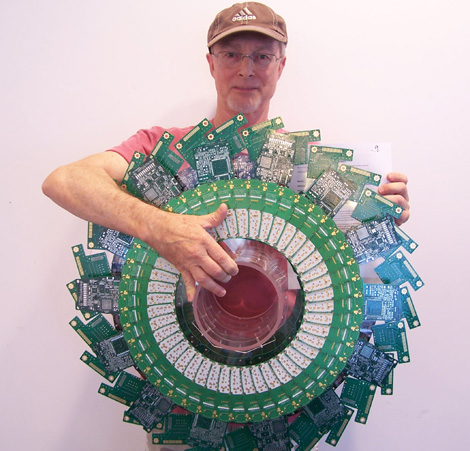Phoenix artist Gary Freitas actually uses today's technology to create his sculptures. "The works are an experimental art medium utilizing the hidden and common detritus of the modern high-tech world — the printed circuit board and related components," explains Freitas, a forensic psychologist born and raised in the San Francisco Bay Area.

He continues: "I believe that these sculptures are among the first efforts to fully reveal the hidden nexus between science and art in this evolving consciousness.And, if current research trends hold true, these circuit board will disappear within the next decade, rendering these art pieces truly unique evolutionary artifacts as well."
In contrast, piñatas are the focus of Beatrice Moore, a Phoenix artist who owns the Kooky Krafts Shop on Grand Avenue, which specializes in handmade items by local artists and crafters.
The curators found her annual Mutant Piñata Show a perfect component for the People's Biennial. As an open call to the public, the show, with an assortment of piñatas by various artists, is not juried and every piece received is showed without distinctions.
Her inclusion in the Biennial is beneficial to the show and to all nontraditional artists and art projects, she says. "Many of these projects benefit the community as a whole and strive for a
more populist and autonomous approach to art-making and art-exhibiting."
Phoenix cardiologist David Hoelzinger hopes that calendars he created when young will also inspire his neighbors in the Valley and other exhibition visitors at the participating museums.
In Vienna, Austria, as a child, his father, who was in the paper business, annually received a calendar as a present. In the one-inch-square boxes of the dates, he began making x's, then notes, then small drawings.
"This gradually evolved into a pictorial diary, with meanings either apparent or hidden in my own symbols," he recalls. "Every picture tells a story, most of which would now be otherwise long forgotten but now serve to remind me of who I am and the people and events that are a part of me. It was also a tool for meditation and contemplation; the day was not complete until it had been so summarized."
He did this for 25 years, but his practices forced its demise. Fortunately, he found the calendars and wanted to share them. "I often asked myself, 'Is it art?' The individual drawings are usually fairly simple, but if art is taking life and converting it into a symbolic form, it fits that definition." He adds: "If just one person were inspired enough to believe that they, too, can create their own art, that would be my reward."
Coblentz sees many rewards in the People's Biennial. For one, the museums participating are in nonmainstream art communities and the artists showing are, for the most part, unknown. More importantly, the exhibition is an opportunity for everyone — artists, curators and community to rethink basic concepts, labels and categories of art. "The People's Biennial," she says, "challenges the traditional semantics and hierarchies of art, exhibitions and exhibition-making in general."
For more information on the show and the fall schedule, see www.smoca.org.
